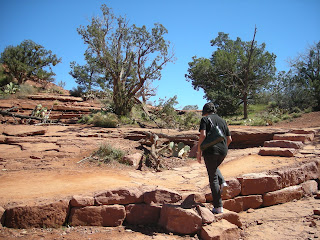
Sedona




Sedona is a city that straddles the county line between Coconino and Yavapai counties in the northern Verde Valley region of the U.S. state of Arizona. As of the 2010 census the population was 10,031.
Sedona's main attraction is its stunning array of red sandstone formations, the Red Rocks of Sedona. The formations appear to glow in brilliant orange and red when illuminated by the rising or setting sun. The Red Rocks form a breathtaking backdrop for everything from spiritual pursuits to the hundreds of hiking and mountain biking trails.






Sedona is named after Sedona Arabelle Miller Schnebly (1877–1950), the wife of Theodore Carlton Schnebly, the city's first postmaster, who was celebrated for her hospitality and industriousness.





Chapel of the Holy Cross



The Chapel of the Holy Cross is a Roman Catholic chapel built into the mesas of Sedona, Arizona, which was inspired and commissioned by sculptor Marguerite Brunswig Staude. Richard Hein was chosen as project architect, and the design was executed by architect August K. Strotz, both from the firm of Anshen & Allen. The chapel is built on Coconino National Forest land; the late Senator Barry Goldwater assisted Staude in obtaining a special-use permit. The construction supervisor was Fred Courkos, who built the chapel in 18 months at a cost of US$300,000. The chapel was completed in 1956.
The American Institute of Architects gave the Chapel its Award of Honor in 1957. In the sculptor's words, “Though Catholic in faith, as a work of art the Chapel has a universal appeal. Its doors will ever be open to one and all, regardless of creed, that God may come to life in the souls of all men and be a living reality.”
In 2007, Arizonans voted the Chapel to be one of the Seven Man-Made Wonders of Arizona, and it is also the site of one of the so-called Sedona vortices.
The Chapel is one of the main tourist attractions in the Sedona area. It is open from 9am to 5pm daily and closed Thanksgiving, Christmas, Good Friday and Easter.
Sedona Vortexes


The vortexes in Sedona are swirling centers of subtle energy coming out from the surface of the earth. The vortex energy is not exactly electricity or magnetism, although it does leave a slight measurable residual magnetism in the places where it is strongest.
No one seems to be able to define it "exactly," but measurable residual magnetism? That means if you bring something that can be magnetized, like iron, into a vortex it should become a magnet. It also means that the red rock, which is red because of its high iron content should have a magnetic charge. And that is somewhat worrying, because like the name suggests, the Airport Vortex is right next to Sedona Airport.
So I did some research, and indeed, the area around Sedona does have magnetic anomalies, meaning compass readings are slightly different than one would expect given the area's declination from true north. So maybe they're on to something.
Or, maybe not.
It seems magnetic anomalies are quite common in Arizona, as. So what makes Sedona special? I don't know. There are a number of different responses in the many shops we visited. Some say that the energy was "spiritual," others said it was "psychic." Some shops sold crystals "charged" with energy from specific vortexes. They did all agree on one thing though: We should experience it for ourselves.
It was the picturesque red rock canyons with their dramatic rock formations that caught the eye of Hollywood location scouts after the second world war. Soon hundreds of western movies and TV episodes were being filmed taking advantage of the Sedona scenery. Ilchi Lee Books
ReplyDelete